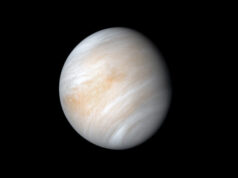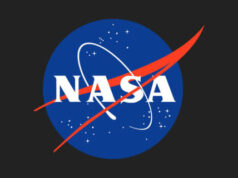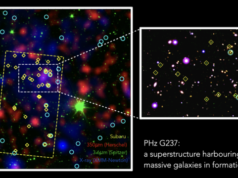NASA’s New Horizons captured this high-resolution enhanced color view of Pluto’s moon Charon, showing the crack on the icy moon. It was taken just before closest approach on July 14, 2015. The image combines blue, red and infrared images and the colors are processed to best highlight the variation of surface properties across Charon. Credit: NASA
A new model developed by University of Rochester researchers could offer a new explanation as to how cracks on icy moons, such as Pluto’s Charon, formed.
Until now, it was thought that the cracks were the result of geodynamical processes, such as plate tectonics, but the models run by Alice Quillen and her collaborators suggest that a close encounter with another body might have been the cause.
Astronomers have long known that the craters visible on moons were caused by the impact of other bodies, billions of years ago. But for every crash and graze, there would have been many more close encounters. By devising and running a new computer model, Quillen, a professor of physics and astronomy at Rochester, has now shown that the tidal pull exerted by another, similar object could be strong enough to crack the surface of such icy moons. Quillen also thinks that “it might even offer a possible explanation for the crack on Mars, but that’s much harder to model.”
Icy moons exhibit what is know as brittle elastic behavior, which Quillen says most resembles “silly putty.”
Find your dream job in the space industry. Check our Space Job Board »
“If you take silly putty and throw it on the floor it bounces — that’s the elastic part,” said Quillen. “But if you pull on it rapidly and hard enough, it breaks apart.”
To simulate the behavior, Quillen modeled the icy moons as if their interior was made up of many bodies connected by springs (an N-body problem with springs). While N-body problems are often used to understand the effect of gravity on planets and stars, N-body problems had never been used to model the inside of an astronomical body, in this case the moons. Other models for icy moons used what are known as “rubble pile models.”
“I was inspired by computer graphics code in how to model the icy moons,” said Quillen. “The inside of the moons is similar to how blood splatter is modeled in games and the outer, icy crust is similar to modeling clothes and how they move. But I had to ensure the code matched the underlying physics!”
To ensure her model took into account the right properties for the materials that make up the moons, she worked with earth sciences Professor Cynthia Ebinger.
“I jumped at the opportunity to consider a novel alternative to plate tectonics, the governing theory to explain earthquakes, volcanoes and moving plates on Earth,” said Ebinger. “My role was to provide some checks and balances to Alice’s modeling and the choice of model parameters.”
In the paper, to be published by the journal Icarus, Quillen states that “strong tidal encounters” may be responsible for the cracks on icy moons such as Charon, Saturn’s Dione and Tethys, and Uranus’ Ariel.
The key factor in determining if a crack is going to occur is the strain rate, the rate of pull from another body that would have caused the moons to deform at a rate that the top, icy layer could not sustain — leading to cracks.
In a companion paper, published in Monthly Notices of the Royal Astronomical Society, Quillen has shown that her models are consistent with the rate at which moons spin up or down when orbiting another object.
Quillen’s and Ebinger’s co-authors on the paper are David Giannella and John G. Shaw, also at the University of Rochester.
The work was in part supported by NASA grant NNX13AI27G.
Source: University of Rochester
Journal Reference:
- Alice C. Quillen, David Giannella, John G. Shaw, Cynthia Ebinger.Crustal failure on icy Moons from a strong tidal encounter. Icarus, 2016; 275: 267 DOI: 10.1016/j.icarus.2016.04.003











